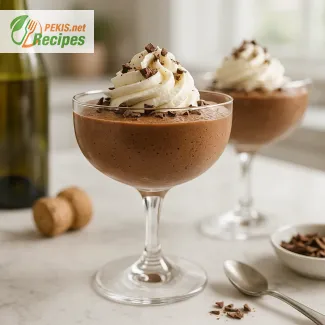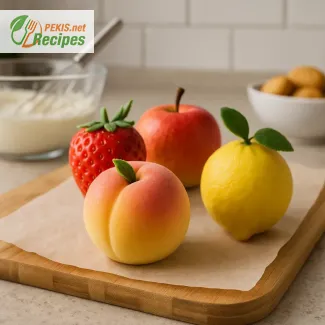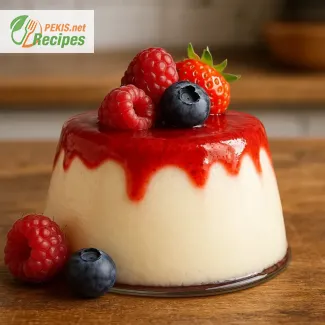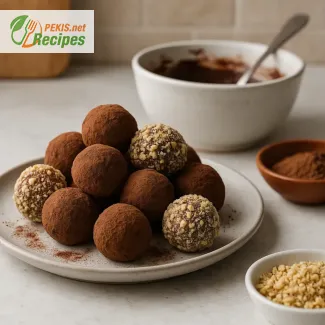Serves 4 with 30 min prep, 90 min cook, total 120 min for golden, crispy-skinned Peking duck layered in soft Mandarin pancakes. Whole duck glazed with honey, soy sauce, rice vinegar, and five-spice delivers tender meat and a lacquered finish. Served with cucumber, spring onions, and hoisin for a rich, authentic bite.
PEKIS – professional chef and recipe developer with over 25 years of experience, specializing in European and international cuisine. This Peking duck recipe has been refined through extensive practice in both home and professional kitchens, focusing on achieving authentic flavor and perfectly crisp skin.

Mastering Crispy Peking Duck at Home
Step-by-step guide to creating authentic flavor and texture
Golden, paper-thin skin that crackles at the bite, tender slices of flavorful duck meat layered inside warm pancakes with sweet bean sauce and fresh vegetables – Peking duck is one of the world’s most celebrated dishes for a reason. Its unmistakable balance of crispiness, juiciness, and rich aroma has made it a hallmark of festive banquets and fine dining tables for centuries. Bringing this iconic delicacy into your own kitchen is both rewarding and surprisingly approachable when broken down into clear, manageable steps.
The origins of Peking duck trace back to the imperial courts of the Yuan Dynasty in China, where chefs perfected the method of roasting whole ducks in brick ovens to achieve that signature lacquered finish. Over the centuries, the dish evolved into a culinary symbol of Beijing, with specialized restaurants elevating it to an art form. Today, while traditional preparation requires dedicated roasting ovens, home cooks can achieve equally impressive results with modern techniques that capture the essence of the original.
Achieving the perfect crispy duck skin is the defining challenge of this recipe. It begins with proper drying of the duck, a gentle infusion of aromatics, and a glazing process that builds layers of flavor while setting the skin for even browning. The cooking process allows fat to render slowly, leaving behind skin that shatters delicately while the meat remains tender and succulent. The final assembly – pairing thinly sliced duck with Mandarin pancakes, cucumber, and scallions – completes the authentic dining experience.
Why you’ll love this recipe
- Crispy, lacquered skin that rivals restaurant quality
- Rich, aromatic meat infused with traditional spices
- Step-by-step method tailored for home kitchens
- Perfect for gatherings and special occasions
- Customizable with your choice of condiments and sides
Serving traditions and pairings
Peking duck is traditionally served with paper-thin pancakes, crisp cucumber batons, fresh scallions, and a rich hoisin or sweet bean sauce. The combination of textures – the crunch of vegetables, the chew of the pancake, and the juicy duck – creates a multi-layered bite that is both refreshing and indulgent. For a modern twist, the meat can also be used in bao buns, lettuce wraps, or even as a topping for savory noodles.
When carving, the skin is often separated and served first for guests to enjoy at its peak crispness, followed by the sliced meat. This allows you to highlight the two different but equally satisfying elements of the dish.
Storage & make-ahead
- Room temperature: up to 2 days (covered)
- Refrigeration: up to 4 days (airtight container)
- Freezing: up to 2 months (portion and wrap tightly)
- Reheating: 150 °C / 300 °F for 8–10 minutes until skin is crisp again
Essential elements for success
- Quality duck with even fat distribution for optimal rendering
- Thorough drying of the skin before cooking to ensure crispness
- Glazing with a balanced sweet-savory mixture for the signature shine
- Controlled roasting temperature to avoid overcooking the meat
- Resting period before carving to keep juices locked in
This combination of traditional techniques and modern kitchen adaptability allows any determined cook to serve a Peking duck that captures the spirit of its centuries-old heritage while being achievable in a home setting.
- Prepare the duck
- Rinse the duck under cold running water and pat completely dry inside and out.
- Remove any excess fat from the cavity and neck area.
- In a large pot, bring 2 L (8 ½ cups) of water to a boil.
- Blanching and skin preparation
- Hold the duck over the sink and ladle the boiling water evenly over the skin to tighten it.
- Pat dry immediately with paper towels.
- Glazing
- In a bowl, mix honey, light soy sauce, rice vinegar, and Chinese five-spice powder until smooth.
- Brush the glaze evenly over the entire duck, ensuring all surfaces are covered.
- Drying
- Hang the duck in a cool, dry place with good air circulation for at least 4 hours or refrigerate uncovered overnight to allow the skin to dry thoroughly.
- Roasting
- Preheat oven to 170 °C (340 °F).
- Place the duck on a wire rack in a roasting tray. Roast for 90 minutes, turning once halfway through.
- During the last 10 minutes, increase the heat to 200 °C (390 °F) to crisp the skin further.
- Carving and serving
- Allow the duck to rest for 10 minutes before carving.
- Slice the skin and meat thinly. Serve with Mandarin pancakes, hoisin sauce, cucumber, and spring onions.
Assembly:
- Place a slice of duck with crispy skin on a pancake.
- Add cucumber and spring onion.
- Drizzle with hoisin sauce, fold, and enjoy immediately.
FAQ questionHow do I get the skin extra crispy?
Ensure the duck skin is completely dry before roasting, ideally by air-drying in the refrigerator overnight. Pouring boiling water over the skin before glazing also tightens it for a crisp finish.
FAQ questionCan I prepare Peking duck without hanging it to dry?
Yes. While traditional hanging improves air circulation, you can place the duck on a wire rack in the refrigerator, uncovered, for several hours to achieve similar results.
FAQ questionWhat is the best substitute for Mandarin pancakes?
If Mandarin pancakes are unavailable, thin flour tortillas or homemade crepes can work as a substitute, though the texture will differ slightly.
FAQ questionIs Peking duck difficult to make at home?
With proper preparation steps—blanching, glazing, drying, and controlled roasting—it’s achievable for home cooks. Following a step-by-step method ensures consistent results.
FAQ questionCan I make the duck ahead of time?
Yes. Cooked duck can be refrigerated for up to 4 days or frozen for up to 2 months. Reheat at 150 °C (300 °F) for 8–10 minutes to restore crispiness.
FAQ questionWhat sauce goes best with Peking duck?
Hoisin sauce is traditional, but sweet bean sauce or plum sauce are also excellent pairings.
FAQ questionHow should I carve the duck?
Use a sharp knife to separate the crispy skin from the meat. Slice both thinly and serve together in pancakes for the best texture combination.
FAQ questionCan I use the leftover duck bones?
Absolutely. Duck bones make a rich, flavorful broth that’s perfect for soups or noodle dishes.
Elevating the Flavor and Texture of Your Peking Duck
Creative adjustments and expert tips for exceptional results
Transforming a Peking duck from delicious to unforgettable comes down to small but strategic adjustments. While the traditional preparation delivers an extraordinary balance of crisp skin and tender meat, there are ways to tailor the flavors, textures, and presentation to your preferences without losing the essence of the dish.
Enhancing the glaze for deeper complexity
The classic glaze of honey, soy sauce, rice vinegar, and five-spice powder can be enriched with dark soy sauce for a richer color and slightly more robust umami profile. Adding a touch of maltose instead of honey creates an even glassier finish, a technique favored in some Beijing kitchens. For a fragrant twist, a splash of Shaoxing wine adds depth and complexity to the aroma.
Infusing the meat with aromatic layers
For those seeking a more pronounced flavor in the meat itself, stuffing the cavity with star anise, ginger, and crushed garlic during roasting infuses the duck from the inside out. These aromatics gently perfume the meat without overpowering it, ensuring each bite carries a subtle warmth beneath the crisp skin.
Adjusting cooking techniques for texture perfection
If a more delicate skin texture is desired, consider double roasting: cook the duck at a lower temperature first to render fat gradually, then chill briefly before returning it to a hotter oven for the final crisping stage. This helps preserve juiciness while maximizing crunch. Using a fan-assisted oven can also accelerate skin drying before roasting.
Health-conscious adaptations without sacrificing taste
To create a lighter version, remove some of the excess subcutaneous fat after blanching but before glazing. Replacing part of the hoisin sauce with homemade plum sauce lowers sugar content while adding a fresh fruit note. Wholegrain or buckwheat-based pancakes can boost fiber while still offering a pleasant chew.
Why home preparation offers an advantage
A home-cooked Peking duck allows complete control over seasoning intensity, quality of ingredients, and the level of crispness in the skin. You can tailor sweetness, saltiness, and spice to your liking while avoiding unnecessary additives often found in commercial versions. This personalization also opens the door to experimenting with sauces, sides, and plating styles.
Common mistakes to avoid
- Skipping thorough drying: Moisture on the skin prevents proper crisping.
- Overcooking the meat: High heat for too long dries out the lean breast portions.
- Underseasoning the glaze: The outer layer needs a bold balance of sweet, salty, and aromatic notes.
- Crowding the oven: Poor air circulation leads to uneven cooking and skin color.
Elevating presentation for a memorable dining experience
Serve the duck in pre-warmed pancakes to maintain softness and prevent tearing. Slice the skin and meat with a sharp carving knife for uniform pieces, and arrange them alongside neatly cut cucumber and scallion batons. A small dish of extra sauce on the side allows guests to adjust the flavor intensity.
Flavor experiments for adventurous cooks
If you enjoy exploring beyond the traditional profile, try incorporating Sichuan peppercorns into the glaze for a mild tingling sensation, or drizzle a light sesame oil finish before serving for nutty warmth. A garnish of fresh coriander can brighten the dish’s richness.
Balancing authenticity with personal style
While the hallmark of Peking duck is its balance between crispness and succulence, introducing thoughtful adjustments can make the dish uniquely yours. By understanding how each element — from glaze composition to roasting method — influences the final result, you can create a version that reflects both tradition and your personal culinary touch.
Allergens present in the recipe:
- Gluten (in Mandarin pancakes, hoisin sauce, soy sauce)
- Soy (in soy sauce, hoisin sauce)
Allergen-free substitutions:
- Use gluten-free pancakes made from rice flour.
- Choose tamari sauce instead of regular soy sauce.
- Select gluten-free hoisin sauce or make your own using gluten-free ingredients.
Vitamins and minerals per serving (approximate):
- Vitamin A: 450 µg – supports healthy vision and immune function
- Vitamin B6: 0.6 mg – aids in brain development and function
- Vitamin B12: 1.8 µg – essential for red blood cell production
- Vitamin C: 7 mg – boosts immune defense
- Vitamin K: 14 µg – important for blood clotting and bone health
- Iron: 4.5 mg – supports oxygen transport in the blood
- Zinc: 3.2 mg – contributes to immune function and wound healing
- Magnesium: 28 mg – important for muscle and nerve function
- Phosphorus: 310 mg – vital for bone and teeth health
Antioxidants per serving (approximate):
- Selenium: 28 µg – protects cells from oxidative stress
- Polyphenols: 45 mg – supports cardiovascular health
- Carotenoids: 0.4 mg – beneficial for eye health
- Flavonoids: 18 mg – may reduce inflammation and improve vascular function





